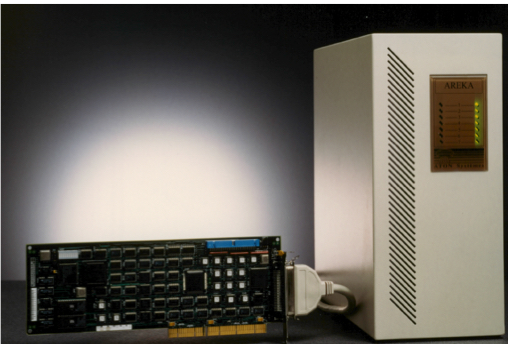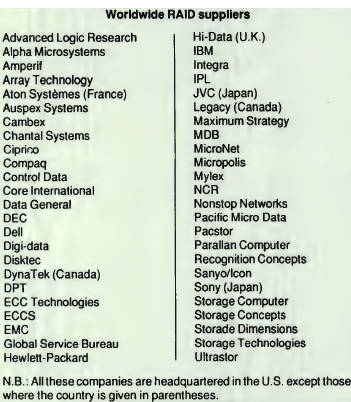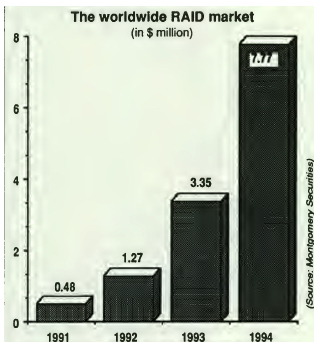History (1992): First French RAID
From Aton Systèmes
By Jean Jacques Maleval | June 10, 2020 at 2:22 pmAbout 50 companies, almost all US ones, are now working on RAIDs (see box below), those famous Redundant Arrays of Inexpensive Disks, a dream for computer users.
Only one French firm, Aton Systèmes in Créteil, in Paris suburbs, is involved in this subject, with an original controller of its own conception.
The three founders of the new company, Alain Besombes, chairman, Dominique Ezvan, director of R&D and Jacques Suzanne, financial manager, come from the former French microcomputer manufacturer SMT Goupil tha twas then already interested in this subject.
They just developed an intelligent controller card, named Unite Multi-Disques Redondante Areka, that can build a RAID subsystem of 3 to 7 disks, with a very high data transfer rate and an unequaled reliability for storage servers that are connected to a microcomputer network.

In the University of Berkley’s RAID classification, the Areka product includes levels 0 and 1.
More precisely, data sectors are not written on the same disks but dispatched on different parallel units (see diagram), which means a much faster transfer rate in write mode as well as in read mode. The choice of directly transmitting data from the disk to the computer’s RAM, without going through the controller’s cache memory, speed, the operation.
Compared to a DPT controller, Aton states transfer rates that can be multiplied by ten.
Access time is also reduced since you can work simultaneously on several of these drives. Additionally, each disk can be doubled to write the same data in parallel. So if a unit breaks down, it is automatically replaced by its “mirror”. You can even do better by adding a hot-fixed disk where data of the failing disk is written as a background task and can then be physically replaced. The drawback of the French firm’s solution is that it takes up a large part of the computer’s RAM (that has to have at least 8MB).

Compared with RAIDs level 3 and 5 for instance, the choice of levels 0-1 demands, for redundancy, to acquire a magnetic surface 2x bigger than necessary. In a 7-disk Areka configuration (3, plus 3 for the mirror, plus a hot-fixed one), the user’s capacity is only equivalent to the 3 units. You can nevertheless select the files that you want to be copied to gain capacity. It’s also true that the price of drives keeps on decreasing and that the architecture offered by Aton has advantage of being performing, flexible, simple, thus cost-efficient.
For an end user, the Areka card will cost FF12,000 with its drivers and will be produced by Alcyon, a Toulouse-based subcontractor, as of June.
Aton aims the Compaq market to begin, the only company to successfully sell a similar solution but that works only with its own computers.
The Areka card attacks the SCSI bus and has a compatible PC/AT interface or a 32-bit EISA interface.
Drivers are written for MS/DOS and Unix, and afterwards for OS/2 and Novell.
Aton should also offer an external cabinet (about FF5,000) with 7×3.5-inch disks and as many power supplies.
With drives of 400MB each, the whole subsystem will cost close to FF100,000 for a useful capacity of 1.2GB.
Created in the beginning of 1991, Aton has a FF250,000 capital where 52.8% is owned by its founders. It expects to reach sales of FF11 million in 1992 and FF22 million in 1992.
WW RAID suppliers

WW RAID market
(in $million)

This article is an abstract of news published on the former paper version of Computer Data Storage Newsletter on issue ≠52, published on May 1992.














 Subscribe to our free daily newsletter
Subscribe to our free daily newsletter


